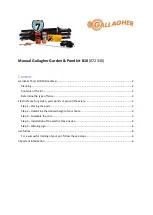
BWS-T4 Series
Instructions manual
Serie BWS-T4
Manuale istruzioni
4
4
3. OPERATION
The control electronic system is fitted inside the control unit. The ‘core’
of the device is made up of two microprocessors forming - as required
by the standards - a system having “two independent channels”. By
means of the suitable hardware, they continuously control and check the
connected photocells. No interference among the photocells is possible
as they are controlled sequentially; it will be thus possible to install two
or more adjacent photocells. When one or more rays are interrupted, the
electronic system opens the output relays signalling which photocells
have triggered by means of LEDs which can be seen on the container. A
display supplies information on the state and on possible failures.
The control-unit can work in two different modes (please refer to par.7)
which he can carry out the following operations:
•
TEST/RESET button: It is used to check if the whole system -
made up of the output relays of the control unit and the machine
actuator - works effectively. By pressing this button (opening the
contact) you practically simulate the interruption of one or more
safety rays and check that the machine stops according to the
established times and modes.
•
START/RESTART button: It is used to start the system which has
been just powered - in case you are in a condition of manual reset
- and to start it again when it has locked after a relay triggering (if
you are in a condition of manual reset) or after an error which can
be reset (see table relating to the error codes).
Two types of different operating modes are also available:
1. Automatic restoring, that is to say after the triggering caused by
the detection of an object: The barrier starts to work again
normally when the object is removed.
2. Manual reset by means of the reset button so that the return to
the normal operating mode takes place only after the object has
been removed and the button has been pressed.
During the barrier working, no operation set by means of the user
interface involves functions which can influence the system safety.
These barriers have also a model with
muting
function on each optical
device. During the operation, this feature makes it possible to connect or
disconnect any available optical device from the protection function by
respecting special times.
3. FUNZIONAMENTO
L’elettronica di controllo è alloggiata all’interno della centralina.
Il cuore del dispositivo è costituito da due microprocessori che
costituiscono, come richiesto dalle normative, un sistema a “due canali
indipendenti”.
Essi provvedono mediante l’apposito hardware, a pilotare e verificare
continuamente le fotocellule collegate. Quando uno o più raggi vengono
interrotti, l’elettronica provvede ad aprire i relè di uscita, segnalando
mediante led visibili sul contenitore quali fotocellule sono intervenute.
Un
display
provvede a fornire indicazioni sullo stato e su eventuali
anomalie.
L'utente dispone di due pulsanti con i quali può compiere le seguenti
operazioni:
•
Pulsante di TEST/RESET: serve a verificare se tutto il sistema
costituito da relè di uscita della centralina più l’attuatore della
macchina è efficiente. Premendo tale pulsante (aprendo il
contatto) in pratica simuliamo l’interruzione di uno o più raggi di
sicurezza e verifichiamo che la macchina si fermi nei tempi e nei
modi definiti.
•
Pulsante di START/RESTART: serve ad avviare il sistema
appena alimentato, nel caso ci troviamo in condizioni di ripristino
manuale, ed a riavviarlo quando è in blocco a seguito di un
intervento (se siamo in condizioni di ripristino manuale) o di un
errore ripristinabile (vedi tabella codici di errore).
La centralina può operare in due diverse modalità di funzionamento
(riferirsi al paragrafo 7):
1. Ripristino automatico, cioè dopo l'intervento causato dal
rilevamento di un oggetto, la barriera riprende il normale
funzionamento nel momento in cui l'oggetto viene rimosso.
2. Ripristino manuale, attraverso il pulsante di ripristino per cui il
ritorno alla modalità operativa normale avviene solo dopo che
l'oggetto è stato rimosso e che il pulsante è stato premuto.
Durante il funzionamento della barriera nessuna operazione impostata
attraverso l'interfaccia utente coinvolge funzioni che possano influire
sulla sicurezza del sistema.
Queste barriere dispongono inoltre di un modello con funzione di
muting
su ciascuna ottica. Tale caratteristica permette durante il funzionamento,
nel rispetto di particolari tempistiche, di escludere o includere dalla
funzione di protezione una qualsiasi delle ottiche disponibili.








































